We’re on holiday in Nairnshire at the moment, so the other morning I dragged my somewhat reluctant family to see what may rank as Scotland’s Most Unprepossessing Pictish Stone.
This is the Kebbuck Stone, a relief-carved cross slab dated to the 8th or 9th century, which today sits in the back garden of a cottage near Ardersier.
It’s usually overlooked in the corpus of early medieval (“Pictish”) stone sculpture because the carvings have almost completely worn away and the surface of the stone is overgrown with lichen.
It was badly eroded even in 1893, when antiquarian George Bain wrote in his History of Nairnshire:
“The slab is very much wasted from the effects of weathering and ill-usage, but the faint outline of a Celtic cross can still be traced upon one side of it. It is a cross of the earliest form—incised and undecorated—and it would have made a most interesting memorial of early Christian times had it been better preserved.
Bain was right that it would have made an interesting memorial (I think it still does), but he was wrong about the cross being incised and undecorated.
I was only able to make out the top edge of the right-hand arm of it, but there’s a photo on Geograph by Ian R. Maxwell, taken in low evening light, that gives a better idea of what the cross looked like:
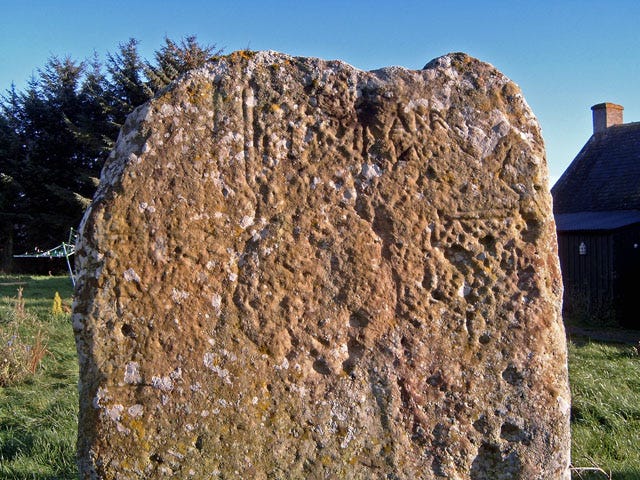
Ian Maxwell’s photo clearly shows that this was a relief-carved cross, with interlace decoration inside the arms and in the central roundel.
A field report by the Early Medieval Carved Stones Project offers a more accurate description than Bain’s (from Canmore):
“This massive cross-slab must once have looked very impressive, carved in relief on both broad faces, but sadly little can now be made out. The better preserved face shows a large cross with circular armpits, interlace-filled arms and an interlace-filled roundel at the centre of the cross-head. The background to the cross was also filled with ornament, best seen now in the top right-hand area of the stone. The back of the stone is severely defaced.”
I couldn’t make out anything on the back of the stone except for some deep linear grooves, which I’ll come back to later. However, if the Kebbuck Stone was like other relief-carved cross-slabs in the Moray Firth area, it may well originally have had two or more Pictish symbols on its reverse face.
Take the so-called Rodney’s Stone, which was discovered in 1781 in Dyke churchyard, 12 miles east of the Kebbuck Stone. It dates to the same general period, but is very much better preserved:
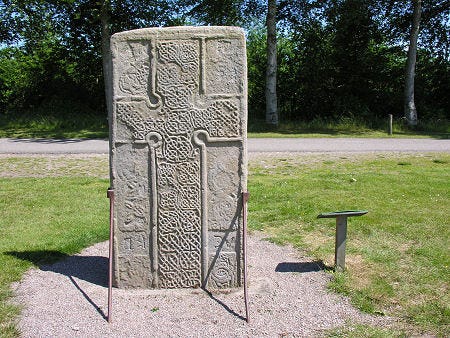
The stones have a few similarities. They’re roughly the same height (Rodney’s Stone is 1.9m tall; the Kebbuck Stone is 1.7m), both are grey sandstone, and the crosses are of broadly similar style, with square arms, circular armpits and interlace detail.
It’s not hard to imagine that the Kebbuck Stone once looked much like Rodney’s Stone. And, tantalisingly, the reverse face of the latter has a superb set of Pictish symbols carved in high relief: a pair of hippocamps (not usually classed as part of the Pictish symbol canon), a “Pictish beast”, and a double-disc and Z-rod.

I do wonder if 3D scanning technology might be able to detect any trace of original carvings on the reverse face of the Kebbuck Stone. It would be wonderful to find a new Pictish symbol stone hiding in plain sight. But realistically, any chance of recovering whatever was carved on it is probably long gone.
[UPDATE 2nd May: Thanks very much to Lorna Morrison of Petty and Ardersier Community Heritage SCIO for letting me know that photogrammetry has been carried out on the Kebbuck Stone by Andy Hickie, revealing faint traces of a cross on the other side. There’s a 3D model on Sketchfab - try the Matcap option for the best view.]
Of cheese and vikings: Legends of the Kebbuck Stone
As with any ancient monument, various legends have attached to the Kebbuck Stone. Most of them relate to cheese – no doubt because “kebbuck” is Scots for a home-made cheese.
The Ordnance Survey Name Book of 1869 summarises these legends, incorporating information provided to the OS examiner by local antiquarians George Cuthbert and Peter Mackenzie (light editing by me):
1st: That the Danes [i.e. vikings] used it as a mooring post for their invading Galleys. The only fact in favour of this tradition is the close proximity of the old beach line of the Moray Firth; but so far as known to the Examiner this tradition has no support from written records.
2nd: That a thief having stolen a cheese (date ancient but unknown) from Inverness Market, he was here overtaken, slain and buried, and this is his monumental Stone; with the effigy of his crime, the Kebbuck - anglice cheese - scratched upon it.
3rd: A local tradition makes this a covenant stone [my emphasis], and George Cuthbert read about 20 years ago in an old Gazetteer of Scotland, while Peter Mackenzie read recently in a small book which he has now managed to lose and is unable to remember its title1, a legend somewhat as follows:
In ancient times (perhaps the books supply the date) a burn ran in the slack to the west of the Kebback Stone, this stream formed the boundary between the Lairds of Delnies and Ardersier, but rainy seasons at times changed its course, which gave rise to bickerings as to the exact boundary, ending often in feud & bloodshed.
On one day the antagonistic Lairds had mustered their tenants for battle when a 3rd Laird from the West Highlands named Cameron attended by a large following appeared on the scene; demanded to be made Mediator & settled the dispute, whereon ensued peace, sealed by a feast of bread, cheese & whisky, and crowned at its close by the heretofore antagonistic tenantry raising this stone as a token of perpetual peace between their feudal lords.
The Circles on the stone commemorate the respective sizes of the Kebbucks furnished by each Laird to the feast, and testify to the liberality of Ardersier in so far as cheese was concerned.”
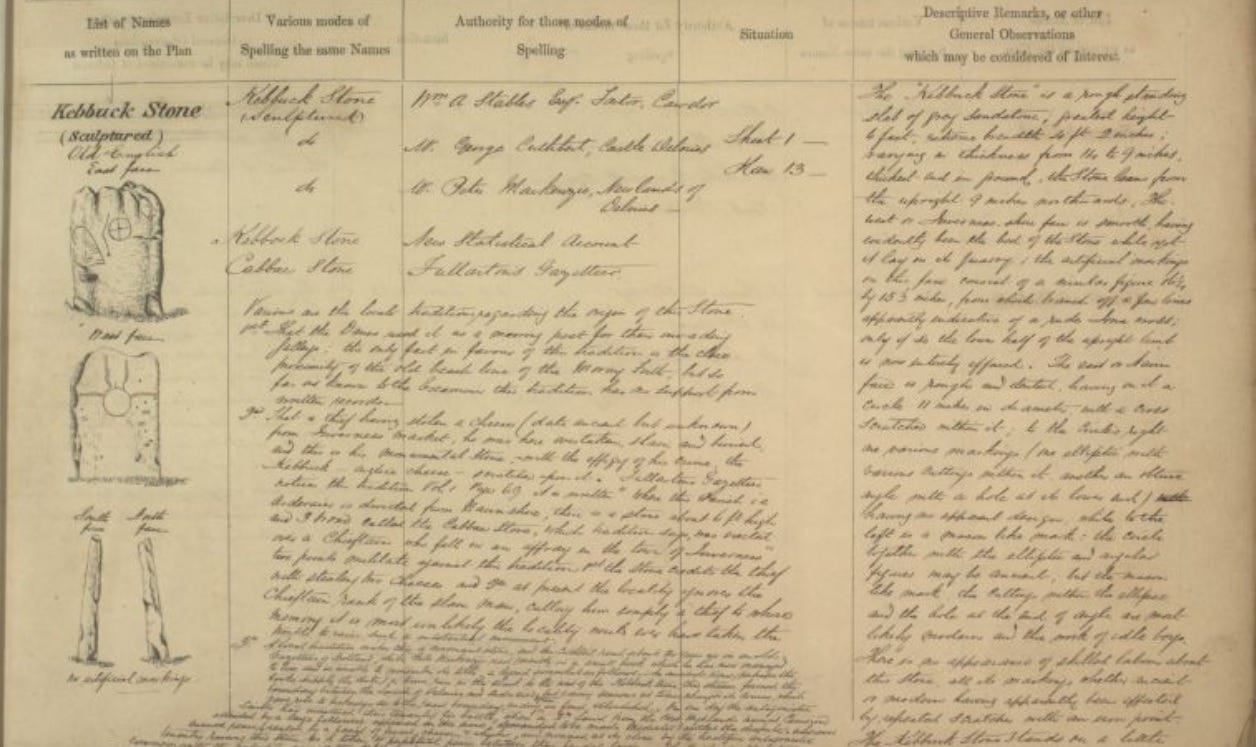
Meanwhile, George Bain in his 1893 History of Nairnshire notes:
…an idle legend has given it the name of the Kebbock stone. The story is that two chiefs and their clans fought a great battle there for possession of a kebbock of cheese.
Red herrings aplenty
There’s clearly a lot of nonsense here, but maybe some smatterings of truth too.
We can discount the idea that the stone had anything to do with kebbucks of cheese, as Scots wasn’t spoken in Nairnshire until the foundation of the burghs in the 12th and 13th centuries.
“Kebbuck” is more likely an echo of its original name, or of the name of the locality, either Pictish or Gaelic. That name probably sounded similar enough to “kebbuck” to prompt an association with cheese, with local imagination then filling in the detail.
We can probably also take with a pinch of salt the idea that the “Danes” used the stone as a mooring post for their invading galleys.
At the time of the first wave of viking sea-raids (throughout the 9th century), the stone would have been fulfilling its original purpose – likely marking the entrance or boundary to a church enclosure (see below). It was probably not near enough to the shore, even taking into account coastal landscape changes, to be used for mooring.
However, this tradition may contain an echo of the idea that when vikings did come raiding, they targeted monasteries and churches for their stealable artefacts.
The Columban monastery on Iona was raided numerous times in the 9th century, and archaeological evidence suggests the monastery at Portmahomack on the north shore of the Moray Firth was burned at around the same time, with indications of violence, though it’s impossible to tell if any of that was the work of viking raiders.
Boundary marker or oath-swearing stone?
Two ideas buried in the legends are probably sound. One is that the stone served as a boundary marker between parishes or landed estates.
Both Bain and the Ordnance Survey Name Book refer to fights between neighbouring lairds, which strongly suggests that the stone was used as a marker to settle land ownership disputes. Over time, this became contorted into a legend of a battle fought over a cheese, or of a resolution celebrated with cheese.
The other, possibly related, is that it was a “covenant stone” – a stone used for the swearing of oaths or witnessing of treaties.
Conor Newman, of the National University of Ireland Galway, has argued very persuasively that cross-slabs in medieval Ireland, Wales and Scotland were used for exactly this purpose. The oath-swearers would signify their assent by drawing their swords across the stone to form a groove.
(He even suggests this may be the origin of the Arthurian sword-in-the-stone legend!)
In a 2009 paper, he writes:
…blade grooves occur with greatest frequency on cross-slabs or cross-inscribed pillar stones, where, as a rule, they are confined to the lower portion of the stone, more often than not close to ground level.
Newman cites a number of stones that seem to have fulfilled this function, noting that they tend to be sacred stones – therefore imbued with a magical power – with connections to important boundaries.
In her (unpublished) 2020 MSc dissertation on Sueno’s Stone, an immense early medieval cross-slab situated about 16 miles east of the Kebbuck Stone, Ruth Loggie makes the connection between Newman’s paper and a series of blade marks found on the lower portion of that stone. Those marks appear in what seems to be a specially-reserved panel, below the cross and a scene interpreted as a royal inauguration.
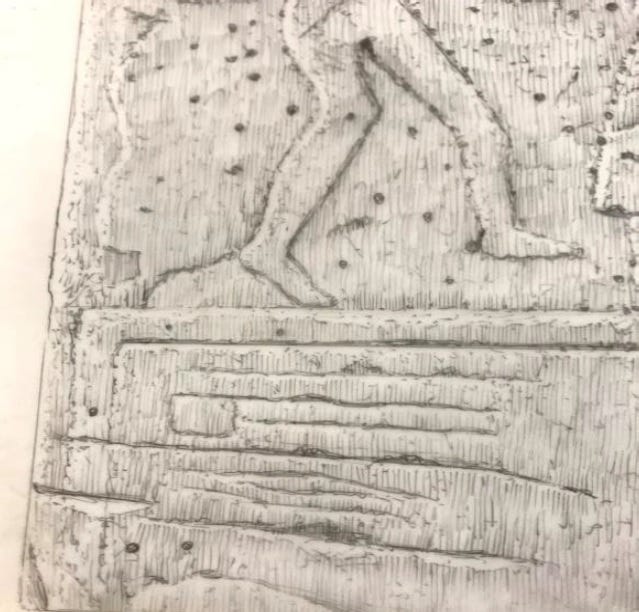
Is it just a coincidence that the Kebbuck Stone also has multiple linear grooves on its reverse face (below)?
In the stone’s Canmore entry, the Early Medieval Carved Stones Project attributes these deep scores to “misuse, e.g. knife sharpening”. But there are such strong parallels with Conor Newman’s findings that the idea of the Kebbuck Stone being a covenant stone seems (to me, at least) highly plausible.
The site of an early medieval church?
Even if the Kebbuck Stone was a parish boundary marker and/or a covenant stone, these would both probably have been secondary uses; later re-purposings of a convenient landmark.
Its original purpose, like other early medieval cross-slabs, may have been to mark the entrance or boundary to a church enclosure. Any early medieval church building is long gone - although George Bain noted in 1893 that “a heap of stones, probably the ruins of an oratory, lay beside the pillar, but has been removed” - but the cross-bearing stone marking its presence survives.
Evidence supporting that theory – possibly, I’m in no way an archaeologist! – is that the cottage immediately to the north of the stone sits on a raised mound, quite distinct from the fields and woods surrounding it.
If there was a church here, why was it here, specifically? There are no place-names in the immediate vicinity to give any clues as to what – if any – kind of settlement might have been here in the first millennium AD.
But the nearby village of Ardersier is from the Gaelic “Àird nan Saor”, according to Iain Mac an Tàilleir’s work for the Scottish Parliament, which he translates as “headland of the joiners”.
Is there a clue there? Ardersier sits opposite Fortrose on the other side of the Moray Firth, and would have been a key crossing point from one side of the Firth to the other. And work done by W.J. Watson, and built on by Simon Taylor, is starting to suggest the name Fortrose may be from Pictish foithir-tros, “place of the crossing”.2
The tradition (according to Wikipedia, at least) is that the joiners of Ardersier were working on the great ecclesiastical buildings across the Firth – making them early bridge and tunnel people, commuting across the water to work on the rich monasteries on the opposite shore.
So did the Kebbuck Stone (and its church) sit beside a routeway to Àird nan Saor and the crossing to Fortrose? Perhaps a routeway that led through Moray – passing Sueno’s Stone and Rodney’s Stone en route – and over to the Black Isle?

Of course, I have no way of telling. But I do like the idea of the Kebbuck Stone being an integral part of the early medieval landscape around the Moray Firth, rather than a slightly sad and forgotten sandstone slab sitting in someone’s back garden.
And if this blog helps to reinstate it in that landscape, that would make me very happy.
Pity the poor 19th-century antiquarians who had no access to Google to find the names of books they’d lost.
I’m eagerly waiting for Groam House Museum in Rosemarkie to publish the notes from a lecture Dr Simon Taylor gave there on Fortrose, Fortriu and the Place-Names of Northern Pictland, which will hopefully be authoritative on the meanings of Fortrose, Ardersier and other places roundabout.

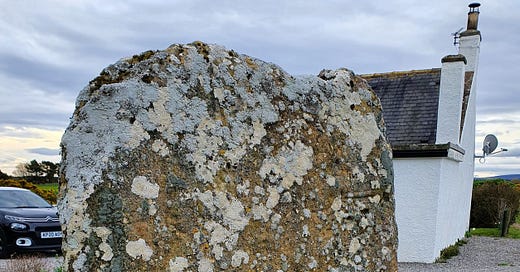



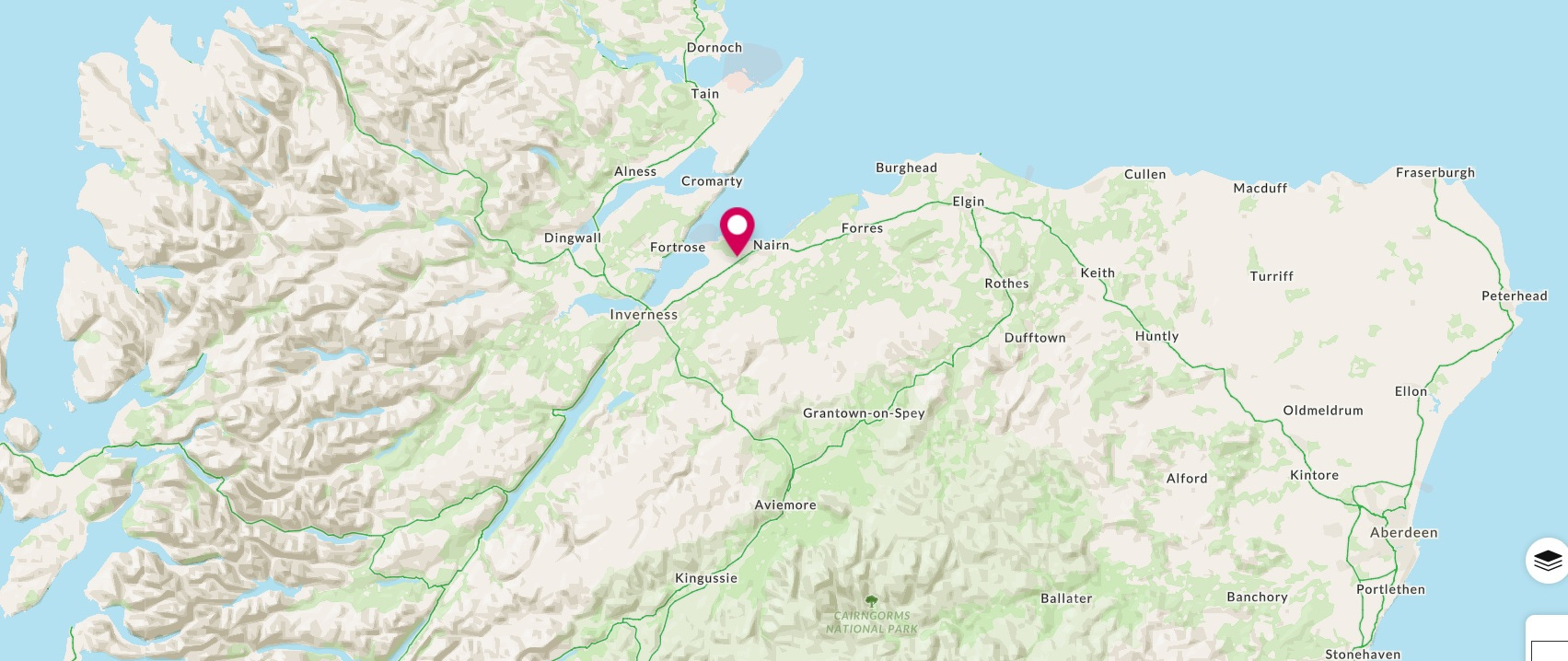

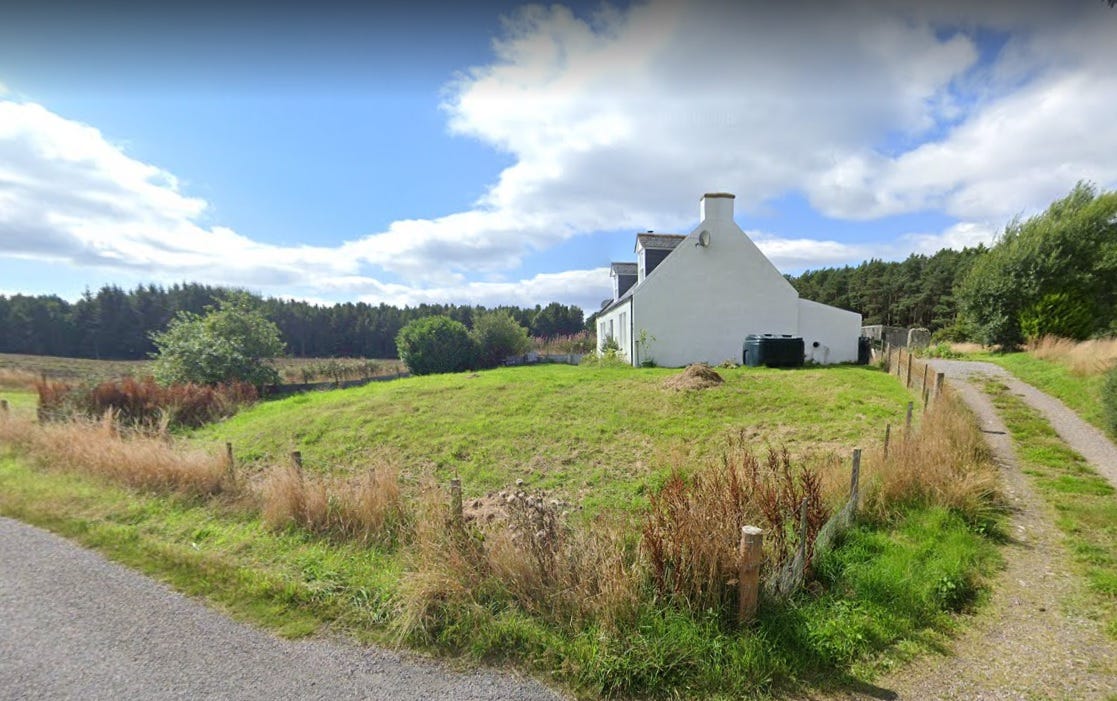
Hi Fiona I am a trustee of the North of Scotland Archaeological Society (NoSAS) and would like to share your fascinating blog with the NoSAS community. I am well aware of the stone and live across the firth in Rosemarkie. Regards Tim Blackie
Great article thank you and reminded my that I should have posted the photogrammetry on to the Highland HER. Andy Hickie worked on this before lockdown and found carvings both sides - there’s more on our Facebook page Lorna (Petty & Ardersier Community Heritage) and on sketchfab. https://www.facebook.com/450047071750132/posts/2734515773303239/